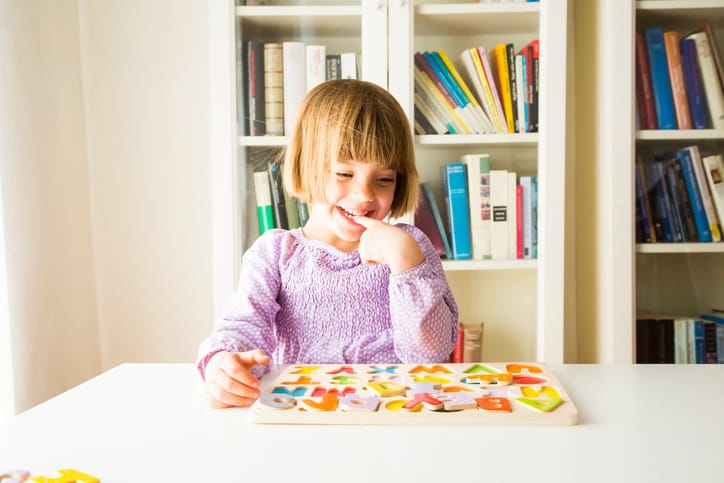Montessori at home: How to help your child learn the ABCs

"Find a friend whose name starts with B."
Everyone knows the alphabet song, but that isn’t always how we go about teaching the ABCs. Montessori teachers start with the phonetic sounds of letters, rather than letter names, and use lots of games and activities to help children understand how letters are used, rather than just memorizing them.
Here are three strategies Montessori teachers use to introduce letters in a fun and effective way.
1. Phonemic awareness
Long before any actual letters are introduced, Montessori teachers work with young children on phonemic awareness, or the ability to hear and isolate individual sounds.
For example, the word dog has three sounds: D/o/g (the word fell also has three sounds: F/e/ll, so it does not always correlate to the number of letters). Montessori teachers play all sorts of games with young children to help them become aware of these individual sounds.
We first practice hearing the initial sound with games like “I Spy.” This game could be played with one child, but is often done with a small group of children who are all practicing their sounds. The teacher might bring a box of small objects to a rug and say, “I spy something that starts with d” (the teacher would say the phonetic sound for ‘d’ rather than the letter name).
Alternatively, a teacher might say, “Look around and see if you can find a friend whose name starts with B.” As the child masters these initial sound games, Montessori teachers introduce similar games isolating the final and middle sounds in words.
Try it at home: There are many variations of this little game and you can easily try it with your child at home, or even in the car when you’re stuck at a red light. This activity should be fun and lighthearted and should never feel like a test. To keep it fun, it’s important not to correct your child if he gets the wrong answer. Just make a mental note that he hasn’t yet mastered the skill.
2. Associating sounds with symbols
Once a child is able to identify sounds within words, he is ready to start working with sandpaper letters.
Sandpaper letters are thin pieces of painted wood with a single letter written in rough sand. The child traces the letter, feeling the shape with his fingers while saying the sound aloud. This teaches him to associate the sound with the symbol, and builds his muscle memory for how to form the letter.
Montessori children learn the phonetic sounds of the letters, rather than the letter names, which helps the child learn to read and write. Most children naturally pick up the letter names later on their own.
Children practice a few letters at a time. Once they master one set, they move on to the next until they know the sounds of all of the letters.
Once a child knows a set of letters pretty well, he may be given a box of objects to match to the letters based on the beginning sound of each object. So if he were practicing the letters C, R and A, he might be given a box with a cat, a rock and an apple to match to the sandpaper letters, solidifying his association of the sound with the letter symbol.
Try this at home: You do not need to buy sandpaper letters to use this technique at home! You can practice the phonetic sounds with your child using things you already have at home like an alphabet puzzle, alphabet book or simply writing lower case letters on little pieces of paper.
If your child is used to hearing the letter name, try saying something like “This is the letter A. It makes the sound A,” saying the phonetic sound for “A.”
3. Three-period lesson
There is one more secret to how Montessori teaches the alphabet: The three-period lesson.
Montessori teachers work hard to maintain children’s confidence and love of learning to foster their natural curiosity and drive. When children are corrected too much, they often become hesitant to try. The three-period lesson helps avoid this problem by testing children’s skills in stages.
The first period is telling a child the name of something: This is “A.”
The second period is asking a child to point to something: Show me “A.” It is easier for a child to point to find the “A” within a group of letters than to come up with the sound on his own. Montessori children spend lots of time in this second-period practice before moving on.
The third period is asking the child the name: What is this? Many people skip straight to this step, but if your child doesn’t readily know the answer, he may lose confidence and be hesitant to try again in the future.
The three-period lesson is an essential part of Montessori, as it protects the child’s fragile sense of confidence as he begins to enter the world of academic skills.
Try this at home: Next time you’re anxious to see what your child knows, try using the three-period lesson rather than just asking him what something is. For example, with an alphabet puzzle, see if he can point to A or B. This will show you what he knows while keeping his confidence strong.
Simply reading and singing to your child go a long way toward helping him learn to read. But if he seems interested in letters and you enjoy practicing together, give these Montessori strategies a try!
You might also like:


































